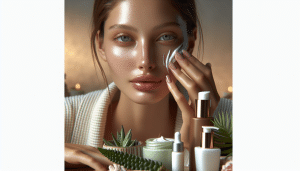Secrets to Glowing Skin You Haven’t Tried
Natalie Brooks November 6, 2025
Explore unique beauty and wellness strategies for naturally glowing skin that most people overlook. This guide covers skin hydration, trending facial treatments, nutrition, gentle skincare routines, proven natural remedies, and expert-approved wellness steps for lasting radiance.
Unlocking the Power of Daily Skin Hydration
Keeping skin hydrated is more than drinking water—consistent, proper hydration helps maintain a healthy skin barrier, crucial for that luminous appearance people seek. Dehydration can reveal lines and dullness, while moisture helps plump surface cells, reduce redness, and support elasticity. Products like serums and creams containing hyaluronic acid and glycerin are increasingly recommended for their ability to help draw moisture into the skin’s layers, offering immediate visible improvements. Pair hydration products with a balanced diet rich in water-filled fruits and vegetables to promote internal and external skin wellness. Skincare choices influence not just appearance, but also how skin repairs itself throughout the day and night.
Not all methods of hydration are equal. Many find that layering lightweight hydrating products can help trap more moisture, preventing trans-epidermal water loss, a leading cause of visible dryness and irritation. Look for ingredients like panthenol, aloe vera, and ceramides in hydrating products. Even the way you wash your face matters—a gentle, fragrance-free cleanser can help maintain natural oils, while over-cleansing can strip moisture and leave skin vulnerable. Listening to your skin’s changing needs, especially with the seasons, allows you to adjust hydration habits for lasting radiance.
External factors like air conditioning, heat, and pollution can also sap moisture and undermine even a diligent hydration routine. Consider using a humidifier in particularly dry environments, and opt for gentle misting sprays during the day. Experts suggest a holistic approach—combining topical and internal hydration—helps support the skin barrier while also preventing premature aging and common skin challenges (Source: https://www.aad.org/public/everyday-care/skin-care-basics/dry/hydrated-skin).
Trending Facial Treatments and At-Home Techniques
Curiosity about professional facial treatments is at an all-time high, but you don’t always need a spa for great results. Innovations like enzyme peels, LED light masks, and microcurrent devices promise smoother, brighter skin with regular use at home. These gadgets and gentle acids can help exfoliate and re-energize the complexion, but proper research ensures safe and effective outcomes. Dermatologists advise a patch test before trying new products or tools, as individual skin reactivity can vary.
Microneedling, facial massage, and lymphatic drainage techniques are also gaining popularity for boosting circulation, sculpting facial contours, and releasing built-up tension in underlying tissues. Regularly massaging the face with upward strokes using a nourishing oil can enhance skin tone and aid absorption of active ingredients. Meanwhile, professional in-office options like hydrafacials and LED therapies exist, but with proper guidance, some benefits can be achieved at home, saving both time and money while pursuing radiant skin (Source: https://www.health.harvard.edu/blog/facial-treatments-spa-home-2020100921274).
Consistency is critical—occasional treatments will not transform your skin long-term. Create a self-care routine that feels sustainable, whether it includes weekly exfoliation with alpha-hydroxy acids, gentle at-home masks, or daily facial massage. Choosing treatments that fit your schedule and skin type allows you to build visible improvement over time, rather than just chasing the latest viral trend.
Nutrition: The Inside-Out Approach to Beauty
What you eat has an undeniable influence on skin health. Vibrant, nutrient-dense foods like leafy greens, colorful berries, nuts, and oily fish are rich in antioxidants and healthy fats, which help fight inflammation and promote a well-nourished, glowing appearance. Some research points specifically to omega-3 fatty acids and vitamin C for their role in supporting collagen production and helping skin stay supple. Integrating a diet filled with diverse, whole foods is a fundamental foundation of a successful beauty routine (Source: https://www.hsph.harvard.edu/nutritionsource/vitamins/vitamin-c/).
Unexpected benefits come from balancing gut health, too. Fermented foods like yogurt, kefir, and kimchi deliver probiotics that nurture the digestive system, which in turn impacts skin clarity and inflammation levels. Studies show that a harmonious gut can lead to fewer breakouts and less redness. Staying aware of potential food sensitivities and minimizing refined sugars also play a part in achieving that healthy glow.
Hydration through diet matter as much as topical care. Herbal teas, pure water, and hydrating fruits help flush toxins and supply skin cells with the moisture needed for plumpness. It’s not about a single miracle food, but the overall pattern of eating—aim for variety, color, and freshness in every meal. Integrate mindful eating into your life and pay attention to how nutrients affect your personal skin journey.
Gentle Skincare Routines for Sensitive Skin
Many struggle with sensitive skin, which can feel dry, itchy, or react to common cosmetic ingredients. The solution doesn’t have to involve complicated routines. Instead, experts advise simplifying, using fragrance-free and hypoallergenic products, and being wary of frequent product switches. Opt for cleansers with a pH close to natural skin and creams containing ingredients like squalane, ceramides, or colloidal oatmeal. These help support the barrier function without triggering irritation (Source: https://www.aad.org/public/diseases/a-z/sensitive-skin).
Patch testing is especially important for anyone prone to sensitivity. Scan ingredient lists carefully, and introduce only one new product at a time every couple of weeks. External factors such as climate, pollution, and even fabric choices can aggravate the complexion. Using cool water over hot, patting the face instead of rubbing, and avoiding harsh physical exfoliants help create a calmer environment for the skin to heal and shine.
Sun protection is a non-negotiable aspect of every skincare routine, but finding mineral-based sunscreens without added fragrance or irritating preservatives is especially important for those with reactive skin. Hats, sunglasses, and clothing with UPF can offer extra peace of mind. Remember that with sensitive skin, less is truly more—let your skin breathe and observe how it responds over time.
Natural Remedies Backed by Science
Plant-based and holistic approaches to beauty routines enjoy growing popularity, but experts urge verifying the claims behind natural remedies. Time-tested remedies like green tea compresses, oatmeal baths, and raw honey masks do have research-backed support for repairing, soothing, or hydrating skin. Green tea, for instance, is rich in antioxidants called catechins that can help reduce inflammation when used topically or consumed regularly (Source: https://www.ncbi.nlm.nih.gov/pmc/articles/PMC5315033/).
Oatmeal is another classic remedy for calming dryness, itch, and minor irritation. Its beta-glucans lock in moisture and encourage healing in compromised skin barriers—proven both anecdotally and in clinical trials. Those experimenting with natural treatments should always choose pure, minimally processed forms and perform a patch test first. Stick to options supported by evidence, and avoid unproven internet trends.
Even essential oils can be useful—lavender oil, for example, offers calming effects and has shown promise for wound healing when diluted appropriately. However, not all oils are appropriate for direct skin contact. Consult with dermatologists or trusted integrative health practitioners before adding new botanicals, and remember that gentleness and consistency matter far more than novelty.
The Wellness Connection: Sleep, Stress, and Movement
A glowing complexion is often the visible result of inner balance. Adequate, restful sleep enables skin to repair and renew overnight. Chronic sleep deprivation can lead to dullness, pronounced under-eye circles, and slower recovery from irritation or damage. Establishing regular bedtimes, keeping screens out of the bedroom, and practicing calming rituals—like chamomile tea or meditation—can make a real difference in overall radiance (Source: https://www.sleepfoundation.org/how-sleep-works/why-do-we-need-sleep).
Stress, both psychological and physical, has a direct impact on barrier function, sebum production, and inflammation. Incorporating relaxation techniques—deep breathing, yoga, time in nature, or even laughter—can reduce the toll stress takes on your skin health. Studies show that regular exercise improves circulation, giving you a natural rosy glow and helping to flush out toxins. Even short daily walks count toward wellness goals.
Balancing the basics of sleep, regular movement, and manageable stress levels creates the foundation for lasting beauty from the inside out. These habits work synergistically with skincare and nutrition, multiplying results without requiring extreme effort. Small changes in daily life can spark visible transformations for your skin and overall sense of wellness.
References
1. American Academy of Dermatology Association. (n.d.). Tips for healthier-looking skin. Retrieved from https://www.aad.org/public/everyday-care/skin-care-basics/dry/hydrated-skin
2. Harvard Health Publishing. (n.d.). Facial treatments: Are they worth the cost and effort? Retrieved from https://www.health.harvard.edu/blog/facial-treatments-spa-home-2020100921274
3. Harvard T.H. Chan School of Public Health. (n.d.). Vitamin C and skin health. Retrieved from https://www.hsph.harvard.edu/nutritionsource/vitamins/vitamin-c/
4. American Academy of Dermatology Association. (n.d.). Sensitive skin care. Retrieved from https://www.aad.org/public/diseases/a-z/sensitive-skin
5. Kim, K. E., & Cho, D. (2017). Skin and the Gut Microbiome. Retrieved from https://www.ncbi.nlm.nih.gov/pmc/articles/PMC5315033/
6. Sleep Foundation. (n.d.). Why do we need sleep? Retrieved from https://www.sleepfoundation.org/how-sleep-works/why-do-we-need-sleep








